Milwaukee CIRCULAR SAW User Manual
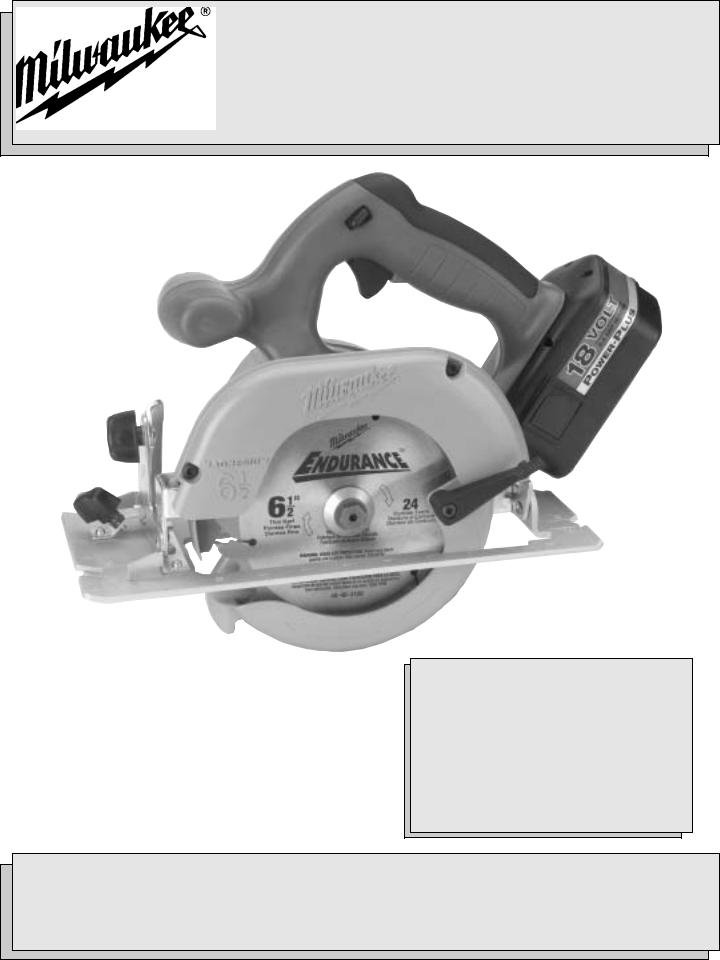
OPERATOR'S MANUAL
MANUEL de L'UTILISATEUR
MANUAL del OPERADOR
No
18 VOLT CIRCULAR SAW SCIE CIRCULAIRE 18V
SIERRA CIRCULAR DE 18V
To extend battery pack life:
•Follow the "BATTERY PACK CARE AND USE" section of this manual.
•Charge battery packs before use.
•Follow the charging instructions in your charger manual.
Pour étendre la durée de vie de la batterie:
•Suivre les instructions de la section «UTILISATION ET ENTRETIEN DE LA BATTERIE» de ce manuel.
•Charger les batteries avant de les utiliser.
•Suivre les instructions de charge du manuel du chargeur.
Para extender la duración de la batería:
•Seguir la sección “USO Y CUIDADO DE LA BATERÍA” en este manual.
•Cargar las baterías antes de usarlas.
•Seguir las instrucciones de carga en el manual del cargador.
TO REDUCE THE RISK OF INJURY, USER MUST READ AND UNDERSTAND OPERATOR'S MANUAL.
AFIN DE RÉDUIRE LE RISQUE DE BLESSURES, L'UTILISATEUR DOIT LIRE ET BIEN COMPRENDRE LE MANUEL DE L'UTILISATEUR.
PARA REDUCIR EL RIESGO DE LESIONES, EL USUARIO DEBE LEER Y ENTENDER EL MANUAL DEL OPERADOR.
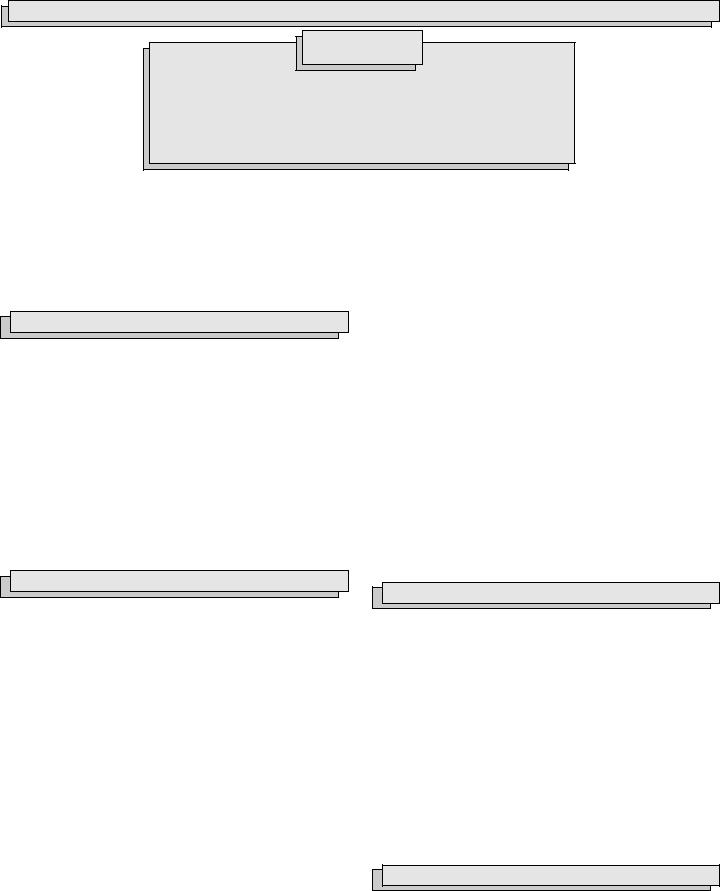
GENERAL SAFETY RULES-FOR ALL BATTERY OPERATED TOOLS
 WARNING!
WARNING!
READ ALL INSTRUCTIONS
Failure to follow all instructions listed below may result in electric shock, fire and/or serious injury. The term "power tool" in all of the warnings listed below refers to your mains-operated (corded) power tool or batteryoperated (cordless) power tool.
SAVE THESE INSTRUCTIONS
|
WORK AREA SAFETY |
|
|
|
POWER TOOL USE AND CARE |
|
|
|
|
|
|
||
|
|
|
|
|
|
|
1.Keep work area clean and well lit. Cluttered or dark areas invite accidents.
2.Do not operate power tools in explosive atmospheres, such as in the presence of flammable liquids, gases, or dust.
Power tools create sparks which may ignite the dust or fumes.
3.Keep children and bystanders away while operating a power tool. Distractions can cause you to lose control.
ELECTRICAL SAFETY
4.Power tool plugs must match the outlet. Never modify the plug in any way. Do not use any adapter plugs with earthed (grounded) power tools. Unmodified plugs and matching outlets will reduce risk of electric shock.
5.Avoid body contact with earthed or grounded surfaces such as pipes, radiators, ranges and refrigerators. There is an increased risk of electric shock if your body is earthed or grounded.
6.Do not expose power tools to rain or wet conditions. Water entering a power tool will increase the risk of electric shock.
7.Do not abuse the cord. Never use the cord for carrying, pulling, or unplugging the power tool. Keep cord away from heat, oil, sharp edges, or moving parts. Damaged or entangled cords increase the risk of electric shock.
8.When operating a power tool outdoors, use an extension cord suitable for outdoor use. Use of a cord suitable for outdoor use reduces the risk of electric shock.
PERSONAL SAFETY
9.Stay alert, watch what you are doing and use common sense when operating a power tool. Do not use a power tool while you are tired or under the influence of drugs, alcohol or medication. A moment of inattention while operating power tools may result in serious personal injury.
10.Use safety equipment. Always wear eye protection. Safety equipment such as dust mask, non-skid safety shoes, hard hat, or hearing protection used for appropriate conditions will reduce personal injuries.
11.Avoid accidental starting. Ensure the switch is in the offposition before plugging in. Carrying tools with your finger on the switch or plugging in power tools that have the switch on invites accidents.
12.Remove any adjusting key or wrench before turning the power tool on. A wrench or a key left attached to a rotating part of the power tool may result in personal injury.
13.Do not overreach. Keep proper footing and balance at all times. This enables better control of the power tool in unexpected situations.
14.Dress properly. Do not wear loose clothing or jewellery. Keep your hair, clothing and gloves away from moving parts.
Loose clothes, jewellery, or long hair can be caught in moving parts.
15.If devices are provided for the connection of dust extraction and collection facilities, ensure these are connected and properly used. Use of these devices can reduce dust-re- lated hazards.
page 2
16.Do not force the power tool. Use the correct power tool for your application. The correct power tool will do the job better and safer at the rate for which it was designed.
17.Do not use the power tool if the switch does not turn it on and off. Any power tool that cannot be controlled with the switch is dangerous and must be repaired.
18.Disconnect the plug from the power source and/or the battery pack from the power tool before making any adjustments, changing accessories, or storing power tools. Such preventive safety measures reduce the risk of starting the tool accidentally.
19.Store idle power tools out of the reach of children and do not allow persons unfamiliar with the power tools or these instructions to operate power tools. Power tools are dangerous in the hands of untrained users.
20.Maintain power tools. Check for misalignment or binding of moving parts, breakage of parts and any other condition that may affect the power tool's operation. If damaged, have the power tool repaired before use. Many accidents are caused by poorly maintained power tools.
21.Keep cutting tools sharp and clean. Properly maintained cutting tools with sharp cutting edges are less likely to bind and are easier to control.
22.Use the power tool, accessories and tool bits etc., in accordance with these instructions and in the manner intended for the particular type of power tool, taking into account the working conditions and the work to be performed. Use of the power tool for operations different from those intended could result in a hazardous situation.
BATTERY TOOL USE AND CARE
23.Ensure the switch is in the off position before inserting battery pack. Inserting the battery pack into power tools that have the switch on invites accidents.
24.Recharge only with the charger specified by the manufacturer. A charger that is suitable for one type of battery pack may create a risk of fire when used with another battery pack.
25.Use power tools only with specifically designated battery packs. Use of any other battery packs may create a risk of injury and fire.
26.When battery pack is not in use, keep it away from other metal objects like paper clips, coins, keys, nails, screws, or other small metal objects that can make a connection from one terminal to another. Shorting the battery terminals together may cause burns or a fire.
27.Under abusive conditions, liquid may be ejected from the battery, avoid contact. If contact accidentally occurs, flush with water. If liquid contacts eyes, additionally seek medical help. Liquid ejected from the battery may cause irritation or burns.
SERVICE
28.Have your power tool serviced by a qualified repair person using only identical replacement parts. This will ensure that the safety of the power tool is maintained.

SPECIFIC SAFETY RULES — CIRCULAR SAWS
1.Maintain labels and nameplates. These carry important information. If unreadable or missing, contact a MILWAUKEE service facility for a free replacement.
2.DANGER! Keep hands away from cutting area and blade. Keep your second hand on auxiliary handle or motor housing. If both hands are holding the saw, they cannot be cut by the blade.
Do not reach underneath the workpiece. The guard cannot protect you from the blade below the workpiece.
Adjust the cutting depth to the thickness of the workpiece.
Less than a full tooth of the blade teeth should be visible below the workpiece.
3.Check lower guard for proper closing before each use. Do not operate the saw if lower guard does not move freely and close instantly. Never clamp or tie the lower guard into the open position. If saw is accidentally dropped, lower guard may be bent. Raise the lower guard with the retracting handle and make sure it moves freely and does not touch the blade or any other part, in all angles and depths of cut.
4.Check the operation and condition of the lower guard spring. If the guard and the spring are not operating properly, they must be serviced before use. Lower guard may operate sluggishly due to damaged parts, gummy deposits, or a buildup of debris.
5.Lower guard should be retracted manually only for special cuts such as "Plunge Cuts" and "Compound Cuts". Raise lower guard by retracting handle and as soon as blade enters the material, the lower guard must be released. For all other sawing, the lower guard should operate automatically.
6.Always observe that the lower guard is covering the blade before placing saw down on bench or floor. An unprotected, coasting blade will cause the saw to walk backwards, cutting whatever is in its path. Be aware of the time it takes for the blade to stop after switch is released.
7.NEVER hold piece being cut in your hands or across your leg. Secure the workpiece to a stable platform. It is important to support the work properly to minimize body exposure, blade binding, or loss of control.
8.Hold power tools by insulated gripping surfaces when performing an operation where the cutting tool may contact hidden wiring or its own cord. Contact with a "live" wire will make exposed metal parts of the tool "live" and shock the operator.
9.When ripping always use a rip fence or straight edge guide.
This improves the accuracy of cut and reduces the chance for blade binding.
10.Always use blades with correct size and shape (diamond vs. round) arbor holes. Blades that do not match the mounting hardware of the saw will run eccentrically, causing loss of control.
11.Never use damaged or incorrect blade washers or bolts.
The blade washers and bolts were specially designed for your saw, for optimum performance and safety of operation.
12.WARNING! Some dust created by power sanding, sawing, grinding, drilling, and other construction activities contains chemicals known to cause cancer, birth defects or other reproductive harm. Some examples of these chemicals are:
•lead from lead-based paint
•crystalline silica from bricks and cement and other masonry products, and
•arsenic and chromium from chemically-treated lumber.
Your risk from these exposures varies, depending on how often you do this type of work. To reduce your exposure to these chemicals: work in a well ventilated area, and work with approved safety equipment, such as those dust masks that are specifically designed to filter out microscopic particles.
13.Causes and Operator Prevention of KICKBACK:
KICKBACK is a sudden reaction to a pinched, bound or misaligned saw blade, causing an uncontrolled saw to lift up and out of the workpiece toward the operator.
When the blade is pinched or bound tightly by the kerf closing down, the blade stalls and the motor reaction drives the unit rapidly back toward the operator.
If the blade becomes twisted or misaligned in the cut, the teeth at the back edge of the blade can dig into the top surface of the wood causing the blade to climb out of the kerf and jump back toward operator.
KICKBACK is the result of saw misuse and/or incorrect operating procedures or conditions and can be avoided by taking proper precautions as given below:
14.Maintain a firm grip with both hands on the saw and position your arms to resist KICKBACK forces. Position your body to either side of the blade, but not in line with the blade. KICKBACK could cause the saw to jump backwards, but kickback forces can be controlled by the operator, if proper precautions are taken.
15.When blade is binding, or when interrupting a cut for any reason, release the trigger and hold the saw motionless in the material until the blade comes to a complete stop. Never attempt to remove the saw from the work or pull the saw backward while the blade is in motion or KICKBACK may occur. Investigate and take corrective actions to eliminate the cause of blade binding.
16.When restarting a saw in the workpiece, center the saw blade in the kerf and check that saw teeth are not engaged into the material. If saw blade is binding, it may walk up or KICKBACK from the workpiece as the saw is restarted.
17.Support large panels to minimize the risk of blade pinching and KICKBACK. Large panels tend to sag under their own weight.
Supports must be placed under the panel on both sides, near the line of cut and near the edge of the panel.
18.Do not use dull or damaged blade. Unsharpened or improperly set blades produce narrow kerf causing excessive friction, blade binding and KICKBACK.
19.Blade depth and bevel adjusting locking levers must be tight and secure before making cut. If blade adjustment shifts while cutting, it may cause binding and KICKBACK.
20.Use extra caution when making a "Plunge Cut" into existing walls or other blind areas. The protruding blade may cut objects that can cause KICKBACK.
page 3
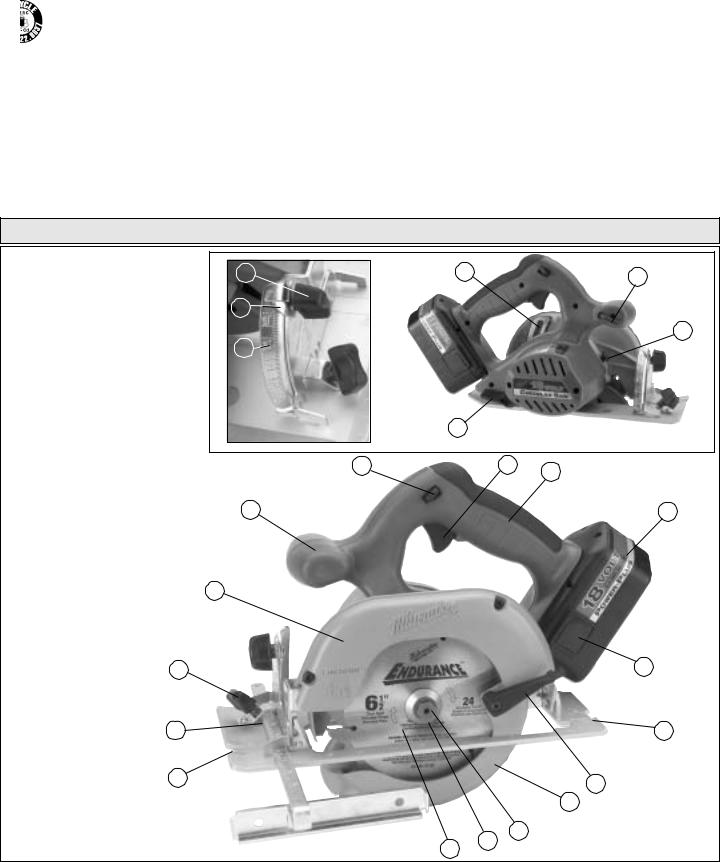
|
Symbology |
|
|
|
Specifications |
|
|
||
|
|
|
|
|
|
|
|
|
|
|
|
|
|
|
|
|
|
|
|
|
Properly Recycle Nickel Cadmium |
|
Cat. |
Volts |
No Load |
Blade |
Arbor |
Depth of Cut |
Depth of Cut |
|
|
No. |
DC |
RPM |
Size |
|
At 90° |
at 45° |
|
|
Batteries |
|
|
||||||
|
|
|
|
|
|
|
|
|
|
|
|
|
6310-20 |
18 |
3200 |
6-1/2" |
5/8" |
0 to 2-1/8" |
0 to 1-9/16" |
|
Volts Direct Current |
|
|
|
|
|
|
|
|
|
|
|
|
|
|
|
|
|
|
|
|
|
|
|
|
|
|
|
|
|
No Load Revolutions per Minute |
|
|
|
|
|
|
|
|
|
|
|
|
|
|
|
|
|
|
|
Underwriters Laboratories, Inc. |
|
|
|
|
|
|
|
|
|
|
|
|
|
|
|
|
|
|
FUNCTIONALDESCRIPTION
21 |
17 |
18 |
|
|
1.Lock-off button
2. |
Trigger |
22 |
|
3. |
Handle |
19 |
|
4. |
Battery |
||
23 |
|||
|
|
5.Battery pack release buttons
6.Shoe
7.Lower guard lever
8.Lower guard
9. |
Blade bolt |
|
20 |
|
10. |
Blade flange |
|
|
|
11. |
Blade |
1 |
2 |
3 |
|
|
|
|
12.Sight line
13.Rip fence slot
16 |
4 |
14. Rip fence adjusting knob |
|
15.Upper guard
16.Front handle
17.Depth setting gauge
18. Wrench |
15 |
|
19.Spindle lock button
20.Depth adjusting lever
21.Bevel adjusting knob
22.Bevel pointer
23. Bevel scale |
14 |
5 |
|
|
|
|
13 |
6 |
12 |
7 |
|
|
|
8 |
|
9 |
|
10 |
|
11 |
page 4
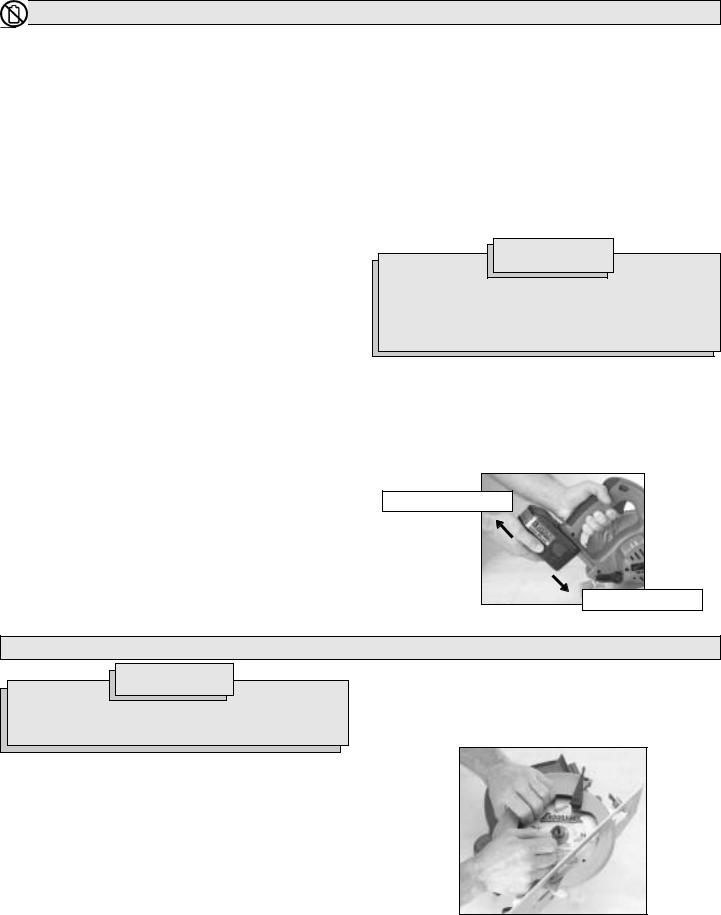
BATTERY PACK CARE AND USE
EXTENDING AND MAINTAINING BATTERY PACK LIFE
MILWAUKEE battery packs will operate for many years and/or hundreds of cycles when they are used, charged, and stored according to these instructions. Properly using, charging, and storing your battery pack can greatly extend its life.
Charge the new battery pack overnight before use to allow the cells to become fully charged. New battery packs are not fully charged. Two to ten normal charging/discharging
cycles may be required before the pack can take its maximum charge.
Never completely discharge the battery pack. MILWAUKEE battery packs do not develop a "memory" when charged after only a partial discharge. Taping-on triggers or leaving work lights
on for extended periods to completely discharge the battery pack will reduce its life by upsetting the electrochemical balance and can result in short-circuiting of the battery.
Do not charge batteries in hot or cold places (below 40°F (5°C) or above 105°F (40°C)). Temperature extremes reduce the ability for battery pack cells to hold a charge. Do not store batteries where the temperature may exceed 120°F (50°C), such as in a vehicle
or metal building during the summer.
To avoid overheating to a battery pack, allow cordless tools cool down between high torque drilling/cutting applications.
The increased energy discharge rate will heat the battery pack cells faster than the cells can release the heat. This could damage the cells.
After use, allow a hot battery pack to cool to room temperature before inserting it into the charger. If a hot battery is put on a charger, charging will not begin until the battery has cooled to a safe temperature. See your charger manual for more information on charging temperatures. Charging a hot battery will damage the cells.
Never forcibly heat up or cool down batteries. This will damage some cells in the pack, causing them to not be able to hold a charge.
Remove the battery pack from the tool for charging when the tool can no longer perform its intended function (i.e., drilling, cutting, etc.).
Leave the battery pack on the charger after it has reached a full charge; the pack will continue to receive a trickle charge to ensure capacity is maintained.
Occasionally (once a week) leave the batteries on the charger overnight to help maintain cell balance.
Do not store the battery on the charger (for more than 24 hours); this could reduce battery life.
Never leave batteries on chargers where power interruptions are common. Damage to the battery cells could occur.
Store batteries at room temperature away from moisture. Do not store in damp locations where corrosion of terminals may occur.
Do not submerge your battery or cordless tools in water. This will damage the battery and tool.
Charge unused batteries overnight at least every six months to maximize battery life. Unused batteries discharge at a rate of about 1% per day and will be fully discharged after six months. For batteries stored for a long time, two to ten normal charging cycles may be required before the pack is fully charged.
Do not use oil or solvents to clean or lubricate your battery pack. The plastic casing will become brittle and crack, causing a risk of injury.
WARNING!
Charge only MILWAUKEE 12, 14.4 and 18 Volt battery packs in MILWAUKEE chargers. Other brands of batteries may explode causing personal injury and damage.
For specific charging instructions, please read the operator's manual supplied with your charger.
Removing Battery Pack from Tool (Fig. 1)
Push in the release buttons and slide the battery pack away from the tool.
Inserting Battery Pack into Tool (Fig. 1)
To insert the battery pack into the tool, push in the release buttons and slide it into the body of the tool.
Fig. 1
Removing a battery pack
Inserting a battery pack
TOOL ASSEMBLY
 WARNING!
WARNING!
To reduce the risk of injury, always remove battery pack before attaching or removing accessories. Use only specifically recommended accessories. Others may be hazardous.
Selecting Blade
Always use sharp blades. Dull blades tend to overload the tool and increase the chance of KICKBACK (see "Causes and Operator Prevention of KICKBACK"). Only use thin kerf blades with a maximum safe operating speed greater than the no load RPM marked on the tool's nameplate. Read the blade manufacturer's instructions before use. Do not use any type of abrasive cut-off wheel or dry diamond cutting blades.
Installing and Removing Blades (Fig. 2 & 3)
1.Remove battery pack before installing or removing blades.
2.Place the saw on a flat surface with the blade facing upwards. To remove the bolt from the spindle, push in the spindle lock button. While holding the spindle lock button in, use the wrench provided with the tool to turn the bolt clockwise (Fig. 2). Remove the bolt and blade flange.
Fig. 2
3.Slide the lower guard lever up to raise the lower guard. Remove the blade from the spindle. Always clean the spindle, upper guard and lower guard to remove any dirt and sawdust.
page 5
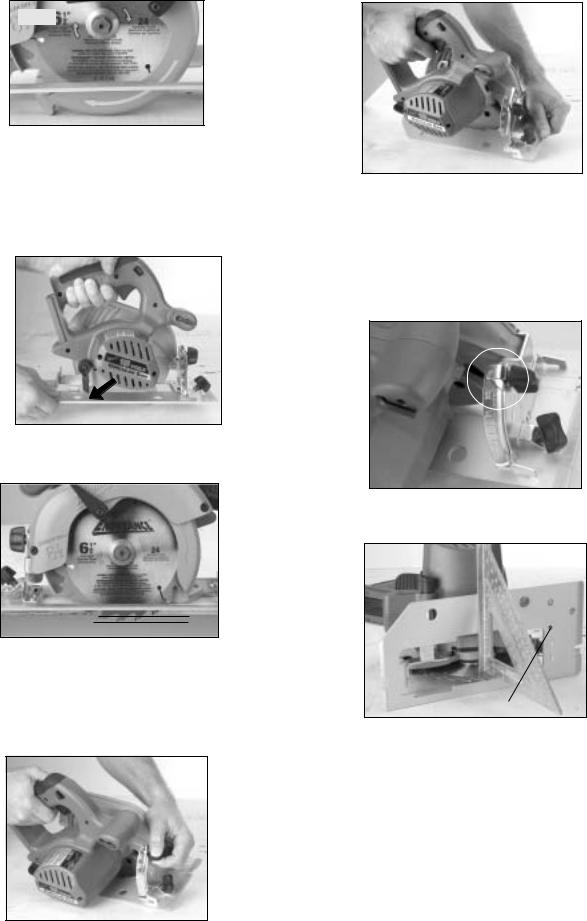
4.To install a blade, place the blade on the spindle with the teeth pointing in the same direction as the arrow on the lower guard (Fig. 3). Release the lower guard lever.
Fig. 3
5.Place the blade flange on the spindle and hand tighten the bolt.
6.While holding the spindle lock button in, use the wrench to turn the bolt counterclockwise and tighten.
Adjusting Depth (Fig. 4 & 5)
1.Remove battery pack.
2.To adjust the depth of the cut, hold the saw by the handle and loosen the depth adjusting lever by pushing it down toward the shoe
(Fig. 4).
Fig. 4
3.Raise or lower the shoe to the desired position. Markings in 1/4" increments are located on the inner side of the upper guard for depth setting. For the proper depth setting, the blade should extend no more than 1/4" below the material being cut (Fig. 5).
Fig. 5
1/4"
4.Lift the depth adjusting lever up towards the motor housing to secure the shoe position.
Adjusting Bevel Angle (Fig. 6 & 7)
1.Remove battery pack.
2.To adjust the angle of the cut, hold the saw by the handle and loosen the bevel adjusting knob. (Fig. 6).
Fig. 6
3.Hold the front of the shoe and rotate the saw by the handle to the desired angle as indicated by the markings on the bevel scale (Fig. 7).
Fig. 7
4.Tighten the bevel adjusting knob securely.
Adjusting the Blade to Shoe (Fig. 8 & 9)
The shoe has been adjusted at the factory to a 90 degree setting. Inspect the saw regularly to make sure the blade is 90 degrees to the shoe.
1.Remove battery pack.
2.Set the bevel pointer to zero (Fig. 8).
Fig. 8
3.To make sure the blade is 90 degrees to the shoe, place saw on the blade side and retract lower guard. Place a square against the blade and shoe to inspect the degree setting (Fig. 9).
Fig. 9
Bevel adjustment screw
4.To adjust the degree setting, loosen the bevel adjusting knob. Turn the bevel adjustment screw in or out until the blade is at a 90 degree angle with the shoe.
5.Tighten the bevel adjusting knob securely.
page 6
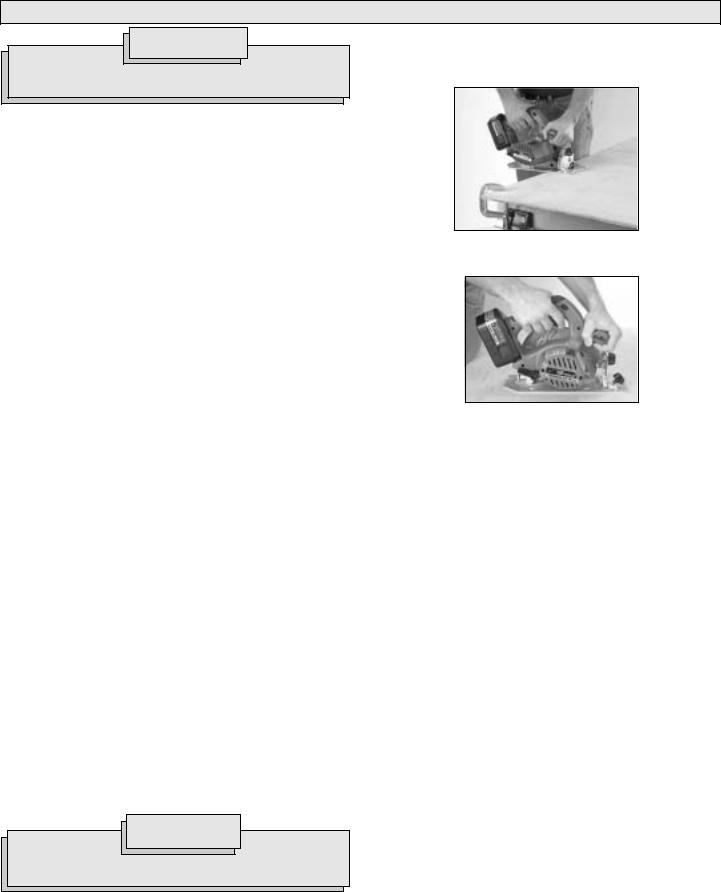
OPERATION
 WARNING!
WARNING!
To reduce the risk of injury, use only specifically recommended accessories. Others may be hazardous.
Causes and Operator Prevention of KICKBACK:
KICKBACK is a sudden reaction to a pinched, bound or misaligned saw blade, causing an uncontrolled saw to lift up and out of the workpiece toward the operator.
When the blade is pinched or bound tightly by the kerf, or cutting slot, closing down, the blade stalls and the motor reaction drives the unit rapidly back toward the operator.
If the blade becomes twisted or misaligned in the cut, the teeth at the back edge of the blade can dig into the top surface of the wood causing the blade to climb out of the kerf and jump back toward operator.
KICKBACK is the result of tool misuse and/or incorrect operating procedures or conditions and can be avoided by taking proper precautions as given below:
1.Maintain a firm grip with both hands on the saw and position your body and arm to allow you to resist KICKBACK forces. KICKBACK forces can be controlled by the operator, if proper precautions are taken.
2.When blade is binding, or when interrupting a cut for any reason, release the trigger and hold the saw motionless in the material until the blade comes to a complete stop. Never attempt to remove the saw from the work or pull the saw backward while the blade is in motion or KICKBACK may occur. Investigate and take corrective actions to eliminate the cause of blade binding.
3.When restarting a saw in the workpiece, center the saw blade in the kerf, or cut, and check that saw teeth are not engaged into the material. If saw blade is binding, it may walk up or KICKBACK from the workpiece as the saw is restarted.
4.Support large panels to minimize the risk of blade pinching and KICKBACK. Large panels tend to sag under their own weight. Supports must be placed under the panel on both sides, near the line of cut and near the edge of the panel.
5.Do not use dull or damaged blades. Unsharpened or improperly set blades produce narrow kerf causing excessive friction, blade binding and KICKBACK.
6.Blade depth and bevel adjusting locking levers must be tight and secure before making cut. If blade adjustment shifts while cutting, it may cause binding and KICKBACK.
7.Use extra caution when making a “Pocket Cut” into existing walls or other blind areas. The protruding blade may cut objects that can cause KICKBACK.
8.Set the depth of cut for no more than 1/8" to 1/4" greater than the thickness of the stock. The less blade exposed, the less chance of binding and KICKBACK. Before cutting, be sure depth and bevel adjustments are tight.
9.Be cautious of pitchy, knotty, wet or warped stock. These are most likely to create pinching conditions and possible KICKBACK. Do not rip warped lumber. Avoid cutting nails.
10.Use a rip fence or edge guide when ripping. Guides improve control and reduce blade binding.
11.Stay alert. Any distraction can cause twisting or binding. Repetitive cuts may lull the user into careless movements.
 WARNING!
WARNING!
To reduce the risk of injury, wear safety goggles or glasses with side shields.
General Operation (Fig. 10 & 11)
Always clamp the workpiece securely on a saw horse or bench
(Fig. 10). See “APPLICATIONS” for the correct way to support your work in different situations.
Fig. 10
1.Draw a cutting line. Place the front of the shoe on the edge of the workpiece without making blade contact. Hold the handle with one hand and the front handle with the other (Fig. 11).
Fig. 11
2.Line up the sight line with your cutting line. Position your arms and body to resist KICKBACK.
3.To start the saw, push the lock-off button down while pulling the trigger. Allow the motor to reach full speed before beginning cut.
4.While cutting, keep the shoe flat against the workpiece and maintain a firm grip. Do not force the saw through the workpiece. Forcing a saw can cause KICKBACK.
5.If making a partial cut, restarting in mid-cut or correcting direction, allow the blade to come to a complete stop. To resume cutting, center the blade in the kerf, back the saw away from cutting edge a few inches, push the lock-off button down while pulling the trigger and re-enter the cut slowly.
6.If the saw binds and stalls, maintain a firm grip and release the trigger immediately. Hold the saw motionless in the workpiece until the blade comes to a complete stop.
7.After finishing a cut, be sure the lower guard closes and the blade comes to a complete stop before setting the saw down.
Electric Brake
This tool features an electric brake. The brake engages when the trigger is released, causing the blade to stop and allowing you to proceed with your work. Generally, the saw blade stops within two seconds. If the brake misses frequently, the saw needs servicing by an authorized MILWAUKEE service facility. The brake is not a substitute for the guard, and you must always wait for the blade to stop completely before removing the saw from the workpiece.
Troubleshooting
If the blade does not follow a straight line:
•Teeth are dull. This is caused by hitting a hard object such as a nail or stone, dulling teeth on one side. The blade tends to cut to the side with the sharpest teeth.
•Shoe is out of line or bent
•Blade is bent
•Rip fence or guide is not being used
If the blade binds, smokes or turns blue from friction:
•Blade is dull
•Blade is on backwards
•Blade is bent
•Blade is dirty
•Workpiece is not properly supported
•Incorrect blade is being used
page 7
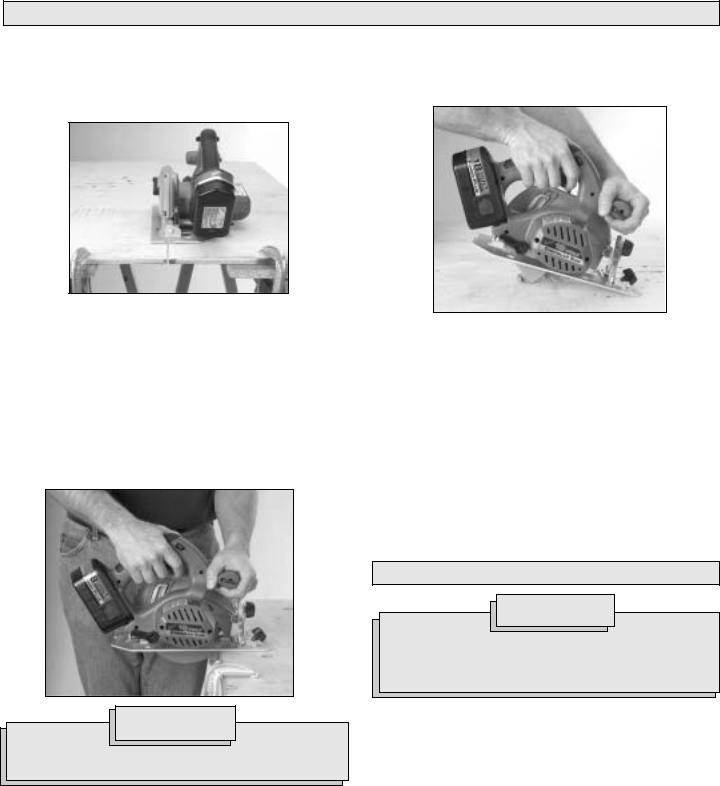
APPLICATIONS
Cutting Large Panels (Fig. 12)
Large panels and long boards sag or bend if they are not correctly supported. If you attempt to cut without leveling and properly supporting the workpiece, the blade will tend to bind, causing KICKBACK.
Support large panels. Be sure to set the depth of the cut so that you only cut through the workpiece, not through the supports.
Fig. 12
Ripping Wood
Ripping is cutting lengthwise with the grain. Select the proper blade for your job. Use a rip fence for rips 4" wide or less. To install the rip fence, slide the bar through the rip fence slot in either side of the shoe. The width of the cut is the distance from the inside of the blade to the inside edge of the rip fence. Adjust the rip fence for the desired width, and lock the setting by tightening the rip fence adjusting knob.
When ripping widths greater than 4", clamp or tack 1" lumber to workpiece and use the inside edge of the shoe as a guide.
Cross-Cutting Wood (Fig. 13)
Cross-cutting is cutting across the grain. Select the proper blade for your job. Advance the saw slowly to avoid splintering the wood.
Fig. 13
WARNING!
To reduce the risk of electric shock, check work area for hidden pipes and wires before making pocket cuts.
Pocket Cutting (Fig. 14)
Pocket cuts are made in the middle of the workpiece when it can not be cut from an edge. We recommend using a Sawzall® reciprocating saw or jig saw for this type of cut. However, if you must use a circular saw to make a pocket cut, USE EXTREME CAUTION. To maintain control of the saw during pocket cutting, keep both hands on the saw (Fig. 14).
1.Beginning at a corner, line up the sight line with your cutting line. Tilt the saw forward, firmly fixing the front of the shoe on the workpiece. The blade should be just above cutting line, but not touching it. Raise the lower guard using the lower guard lever.
2.To start the saw, push the lock-off button down while pulling the trigger. Allow the motor to reach full speed before beginning cut.
Using the front of the shoe as a hinge point, gradually lower the back end of the saw into the workpiece. Release the lower guard lever and grasp the front handle.
Fig. 14
3.When the shoe rests flat against workpiece, advance the saw to the far corner. Release the trigger and allow the blade to come to a complete stop before removing it from workpiece. Repeat the above steps for each side of the opening. Use a Sawzall® reciprocating saw, jig saw or small hand saw to finish the corners if they are not completely cut through.
ACCESSORIES
WARNING!
To reduce the risk of injury, always remove battery pack before attaching or removing accessories. Use only specifically recommended accessories. Others may be hazardous.
For a complete listing of accessories refer to your MILWAUKEE Electric Tool catalog or go on-line to www.milwaukeetool.com. To obtain a catalog, contact your local distributor or a service center.
Thin Kerf Blades
Special thin kerf blade designed for cordless circular saws.
24 Tooth Blade
Cat. No. 48-40-4108
40 Tooth Blade
Cat. No. 48-40-4112
Blade Wrench (Allen)
Cat. No. 49-96-0080
Blade Wrench
Cat. No. 49-46-6205
Rip Fence
Cat. No. 49-22-1001
page 8

MAINTENANCE
WARNING!
To reduce the risk of personal injury always unplug the charger and remove the battery pack from the charger or tool before performing any maintenance. Never disassemble the tool, battery pack or charger. Contact a MILWAUKEE service facility for ALL repairs.
Keep your tool, battery pack and charger in good repair by adopting a regular maintenance program. After six months to one year, depending on use, return the tool, battery pack and charger to a MILWAUKEE service facility for:
•Lubrication
•Brush inspection and replacement
•Mechanical inspection and cleaning (gears, spindles, bearings, housing, etc.)
•Electrical inspection (battery pack, charger, motor)
WARNING!
To reduce the risk of explosion, never burn a battery pack even if it is damaged, dead or completely discharged.
RBRC Battery Recycling Seals
The RBRC™ Battery Recycling Seals (see "Symbology") on your tool battery packs indicate that MILWAUKEE has arranged for the recycling of that battery pack with the Rechargeable Battery Recycling Corporation (RBRC).
At the end of your battery pack's useful life, return the battery pack to a
MILWAUKEE Branch Office/Service Center or the participating retailer nearest you. For more information, visit the RBRC web site at www.rbrc.org.
Disposing of Nickel-Cadmium Battery Packs
Nickel-Cadmium battery packs are recyclable. Under various state and local laws, it may be illegal to dispose of this battery into the municipal
•Testing to assure proper mechanical and electrical waste stream. Dispose of your battery pack according to federal, state
operation
Maintaining Tool
If the tool does not start or operate at full power with a fully charged battery pack, clean the contacts on the battery pack. If the tool still does not work properly, return the tool, charger and battery pack to a MILWAUKEE service facility for repairs.
Maintaining Battery Pack
MILWAUKEE battery packs will operate for many years and/or hundreds of cycles when they are maintained and used according to these instructions.
A battery pack that is stored for six months without being used will discharge itself. Batteries discharge at a rate of about 1% per day.
Charge the battery every six months even if it is unused to maximize battery life. Do not tape the trigger in the “ON” position and leave the tool unattended as this may discharge the battery to a point where it will no longer be able to recharge. Use a MILWAUKEE Battery Pack only until it no longer performs with the power and torque needed for your application.
Store your battery pack in a cool, dry place. Do not store it where the temperature may exceed 120°F (50°C) such as in a vehicle or metal building during the summer. High temperatures will overheat the battery pack, reducing battery life. If it is stored for several months, the battery pack will gradually lose its charge. One to three cycles of charging and discharging through normal use will restore the capacity of the battery pack. During the life of the battery pack, the operating time between charges becomes shorter. If the operating time becomes extremely short after a proper charge, the usable life of the battery pack has been reached and it should be replaced.
 WARNING!
WARNING!
To reduce the risk of personal injury and damage, never immerse your tool, battery pack or charger in liquid or allow a liquid to flow inside them.
Cleaning
Clean dust and debris from charger and tool vents. Keep tool handles clean, dry and free of oil or grease. Use only mild soap and a damp cloth to clean the tool, battery pack and charger since certain cleaning agents and solvents are harmful to plastics and other insulated parts. Some of these include gasoline, turpentine, lacquer thinner, paint thinner, chlorinated cleaning solvents, ammonia and household detergents containing ammonia. Never use flammable or combustible solvents around tools.
and local regulations.
Repairs
If your tool is damaged, return the entire tool to the nearest service center.
Battery Pack Warranty
Battery packs for cordless tools are warranted for one year from the date of purchase.
FIVE YEAR TOOL LIMITED WARRANTY
Every MILWAUKEE tool is tested before leaving the factory and is warranted to be free from defects in material and workmanship. MILWAUKEE will repair or replace (at MILWAUKEE’s discretion), without charge, any tool (including battery chargers) which examination proves to be defective in material or workmanship from five (5) years after the date of purchase. Return the tool and a copy of the purchase receipt or other proof of purchase to a MILWAUKEE Factory Service/Sales Support Branch location or MILWAUKEE Authorized Service Station, freight prepaid and insured. This warranty does not cover damage from repairs made or attempted by other than MILWAUKEE authorized personnel, abuse, normal wear and tear, lack of maintenance, or accidents.
Battery Packs, Flashlights, and Radios are warranted for one (1) year from the date of purchase.
THE REPAIR AND REPLACEMENT REMEDIES DESCRIBED HEREIN ARE EXCLUSIVE. IN NO EVENT SHALL MILWAUKEE BE LIABLE FOR ANY INCIDENTAL, SPECIAL, OR CONSEQUENTIAL DAMAGES, INCLUDING LOSS OF PROFITS.
THIS WARRANTY IS EXCLUSIVE AND IN LIEU OF ALL OTHER WARRANTIES, OR CONDITIONS, WRITTEN OR ORAL, EXPRESSED OR IMPLIED FOR MERCHANTABLILITY OR FITNESS FOR PARTICULAR USE OR PURPOSE.
This warranty gives you specific legal rights. You may also have other rights that vary from state to state and province to province. In those states that do not allow the exclusion of implied warranties or limitation of incidental or consequential damages, the above limitations or exclusions may not apply to you. This warranty applies to the United States, Canada, and Mexico only.
page 9
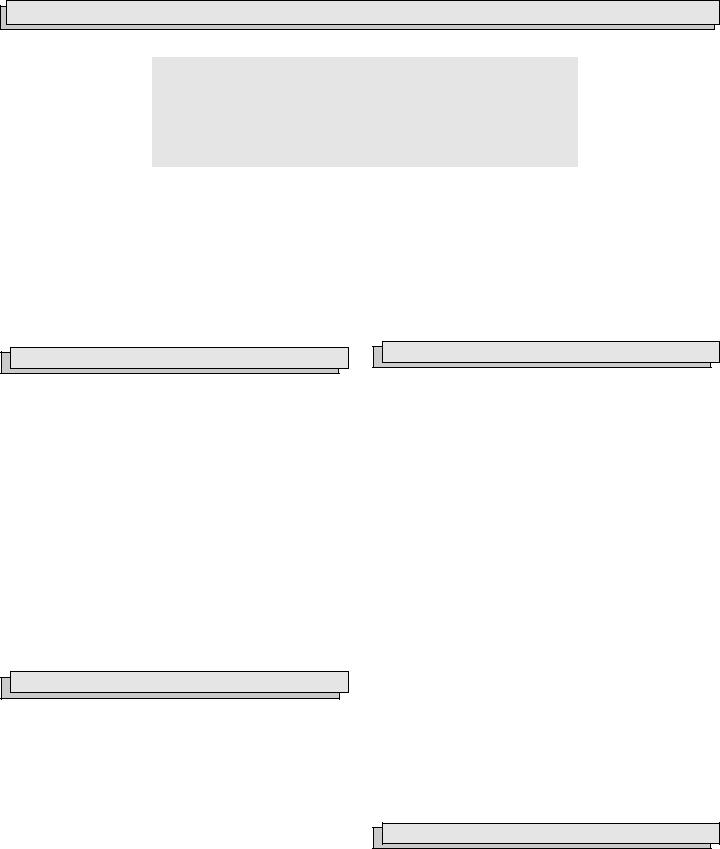
RÈGLES GÉNÉRALES DE SÉCURITÉ POUR LES OUTILS ALIMENTÉS PAR BATTERIE
|
|
|
|
|
|
AVERTISSEMENT! |
|
|
|
|
||
|
|
|
|
|
|
|
|
|
||||
|
|
|
|
|
|
|
|
|||||
|
|
|
|
|
|
|
|
|
|
|
|
|
|
|
|
|
|
|
|
|
|
|
|
|
|
|
|
|
LIRE SOIGNEUSEMENT TOUTES LES INSTRUCTIONS |
|
|
|||||||
|
|
|
Le non respect des instructions ci-après peut entraîner des chocs |
|
|
|||||||
|
|
|
électriques, des incendies et/ou des blessures graves. Le terme «outil |
|
|
|||||||
|
|
|
électrique» figurant dans les avertissements ci-dessous renvoie à l’outil |
|
|
|||||||
|
|
|
électrique à alimentation par le réseau (à cordon) ou par batterie (sans fil). |
|
|
|||||||
|
|
|
CONSERVER CES INSTRUCTIONS |
|
|
|||||||
|
|
|
|
|
|
|
|
|
|
|
|
|
|
|
|
|
|
|
|
13. Ne pas travailler à bout de bras. Bien garder un bon équilibre |
|||||
|
SÉCURITÉ DU LIEU DE TRAVAIL |
|
||||||||||
|
|
|||||||||||
|
|
à tout instant. Ceci permet de mieux préserver la maîtrise de l’outil |
||||||||||
|
|
|
|
|
|
|
électrique dans des situations imprévues. |
|||||
1. Maintenir la zone de travail propre et bien éclairée. Les zones |
||||||||||||
14. Porter des vêtements adéquats. Ne pas porter de vêtements |
||||||||||||
|
encombrées ou mal éclairées sont favorables aux accidents. |
|||||||||||
|
amples ni de bijoux. Ne pas approcher les cheveux, |
|||||||||||
2. Ne pas utiliser d’outil électrique dans une atmosphère ex- |
||||||||||||
vêtements et gants des pièces en mouvement. Les vêtements |
||||||||||||
|
plosive, telle qu’en en présence de liquides, de gaz ou de |
|||||||||||
|
amples, les bijoux ou les cheveux longs risquent d’être happés par |
|||||||||||
|
poussières inflammables. Les outils électriques génèrent des |
|||||||||||
|
les pièces en mouvement. |
|||||||||||
|
étincelles qui peuvent enflammer les poussières ou les fumées. |
|||||||||||
|
15. Si des dispositifs sont prévus pour l’extraction et la |
|||||||||||
3. Tenir les enfants et les personnes non autorisées à l’écart |
||||||||||||
récupération des poussières, vérifier qu’ils sont connectés |
||||||||||||
|
pendant le fonctionnement d’un outil électrique. Un manque |
|||||||||||
|
et utilisés correctement. L’utilisation de ces dispositifs peut |
|||||||||||
|
d’attention de l’opérateur risque de lui faire perdre le contrôle de |
|||||||||||
|
réduire les risques liés aux poussières. |
|||||||||||
|
l’outil. |
|||||||||||
|
|
|
|
|
|
|||||||
SÉCURITÉ ÉLECTRIQUE
4.La fiche de l’outil électrique doit correspondre à la prise d’alimentation. Ne jamais modifier la fiche d’une manière quelconque. Ne pas utiliser d’adaptateur avec les outils électriques mis à la terre (à la masse). Des fiches non modifiées et des prises d’alimentation assorties réduisent le risque de choc électrique.
5.Éviter tout contact corporel avec des surfaces reliées à la masse ou à la terre telles que tuyaux, radiateurs, cuisinières et réfrigérateurs. Un risque de choc électrique plus élevé existe si le corps est relié à la masse ou à la terre.
6.Ne pas exposer les outils électriques à la pluie ou à l’humidité. Le risque de choc électrique augmente si de l’eau s’infiltre dans un outil électrique.
7.Prendre soin du cordon. Ne jamais utiliser le cordon pour transporter, tirer ou débrancher l’outil électrique. Tenir le cordon à l’écart de la chaleur, des huiles, des arêtes coupantes ou des pièces en mouvement. Un cordon endommagé ou emmêlé présente un risque accru de choc électrique.
8.Se procurer un cordon d’alimentation approprié en cas d’utilisation d’un outil électrique à l’extérieur. L’utilisation d’un cordon d’alimentation pour usage extérieur réduit le risque de choc
électrique.
SÉCURITÉ INDIVIDUELLE
9.Être sur ses gardes, être attentif et faire preuve de bon sens en utilisant un outil électrique. Ne pas utiliser un outil électrique en cas de fatigue ou sous l’influence de drogues, d’alcool ou de médicaments. Un instant d’inattention lors de l’utilisation d’un outil électrique peut entraîner des blessures graves.
10.Utiliser un équipement de sécurité. Toujours porter des lunettes de protection. Un équipement de sécurité comprenant masque anti-poussière, chaussures de sécurité anti-dérapantes, casque ou dispositif de protection anti-bruit peut, dans les circonstances appropriées, réduire le risque de blessure.
11.Éviter tout démarrage accidentel de l’outil. S’assurer que le commutateur est en position OFF (Arrêt) avant de brancher l’outil. Le port de l’outil avec un doigt sur le commutateur ou son branchement avec le commutateur en position ON (Marche) sont favorables aux accidents.
12.Retirer toute clé de réglage avant de mettre l’outil sous tension. Une clé laissée attachée sur une pièce mobile de l’outil
électrique peut entraîner des blessures.
UTILISATION ET ENTRETIEN DE L’OUTIL ÉLECTRIQUE
16.Ne pas forcer l’outil électrique. Utiliser l’outil électrique approprié à l’application considérée. L’outil électrique adapté au projet considéré produira de meilleurs résultats, dans des conditions de sécurité meilleures, à la vitesse pour laquelle il a été conçu.
17.Ne pas utiliser l’outil électrique si le commutateur ne le met pas sous ou hors tension. Tout outil électrique dont le commutateur de marche-arrêt est inopérant est dangereux et doit
être réparé.
18.Débrancher la fiche de la prise d’alimentation et/ou la batterie de l’outil électrique avant d’effectuer des réglages, de changer d’accessoires ou de ranger l’outil. De telles mesures de sécurité préventive réduisent le risque de mettre l’outil en marche accidentellement.
19.Ranger les outils électriques inutilisés hors de la portée des enfants et ne pas laisser des personnes qui connaissent mal les outils électriques ou ces instructions utiliser ces outils. Les outils électriques sont dangereux dans les mains d’utilisateurs non formés à leur usage.
20.Entretien des outils électriques. S’assurer de l’absence de tout désalignement ou de grippage des pièces mobiles, de toute rupture de pièce ou de toute autre condition qui pourrait affecter le bon fonctionnement de l’outil électrique. En cas de dommages, faire réparer l’outil avant de l’utiliser de nouveau. Les outils électriques mal entretenus sont à la source de nombreux accidents.
21.Garder les outils de coupe affûtés et propres. Les outils de coupe correctement entretenus et bien affûtés risquent moins de se gripper et sont plus faciles à manier.
22.Utiliser cet outil électrique, les accessoires, les mèches, etc. conformément à ces instructions et de la façon prévue pour ce type particulier d’outil électrique, tout en prenant en compte les conditions de travail et le type de projet considérés. L’utilisation de cet outil électrique pour un usage autre que l’usage prévu peut créer des situations dangereuses.
UTILISATION ET ENTRETIEN DE LA BATTERIE
23.S’assurer que le commutateur est en position OFF (Arrêt) avant d’insérer la batterie. L’insertion de la batterie dans un outil
électrique dont le commutateur est en position ON (Marche) est favorable aux accidents.
page 10
